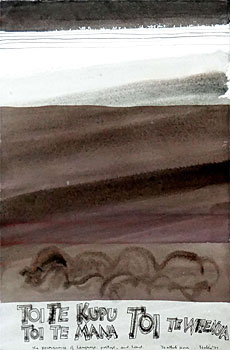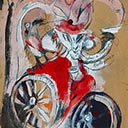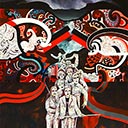Toi te Kupu. Toi te Mana, Toi te Whenua
58.8 x 39.5 cm
Provenance:
Private Collection since 1972
"As statements of commitment to political and social issues, the works [of Hotere's `Te Whiti series] are clearly voiced, with titles such as Toi te kupu, Toi te mana, Toi te whenua (the permanence of language, prestige and land).. .The Te Whiti works...were concerned with the layering of written language over landforms, evoking the Treaty of Waitangi and the whole history of colonisation, as well as acknowledging McCahon's work..."
Gregory O'Brien: Hotere - Out the Black Window, Ralph Hotere's work with New Zealand Poets, Godwit/City Gallery, Wellington, 1997 p 78
"For Te Whiti o Rongomai, the plough was more than an implement for turning soil, it was emblematic of the dreams and aspirations of an evolving Maori community... In ploughing the soil beyond Parihaka, the Taranaki ploughmen were inscribing a text into the land - a written assertion of rangatiratanga, of spiritual and material attachment and sovereignty...If the plough has been a symbol of attachment to the land, it has at other times been a symbol of iconoclasm. Importantly, Parihaka history reiterates both these associations... The ploughed line in the landscape has an analogue in the line left by the tattooist's chisel or needle. Traditional Maori moko is a furrow drawn onto the human skin- its parallel formations contain history, wisdom and whakapapa...
Ralph Hotere began producing line drawings based on symmetrical landscape motifs in the late 1960s, when one such work appeared on the cover of James K. Baxter's Jerusalem Sonnets. While in subsequent series such as Requiem, 1973 and Song Cycle, 1975, Hotere used formations of lines which were almost exclusively vertical - giving the feeling of rain falling or a forest growing - in the Te Whiti series, 1972 and other early landscapes we see flattened paddocks and horizons. These works assert the fundamental importance of land as 'a mother that never dies'...
The Te Whiti works are acts of painterly ploughing. If some incorporate formations of lines suggesting, literally, the inscribing of lines into the earth, others offer pared down settings of storm-tossed, ravaged or obliterated horizons. Like the work of Mark Rothko, these are subtle orchestrations of darkness and muted, numinous colour. An earthen orange-brown smoulders beneath layers of blackness in many works. But Hotere will not leave this darkness alone. Words are dug into the fabric of these works - they are etched, scrawled, sprayed and delicately written.
From the early 1960s onwards, Hotere was using language to expand the visual, symbolic and literal content of his art.. .Importantly, the Te Whiti series established longer texts as a viable component in his art. Embarking on the series in 1972, Hotere chose to base his work around extracts from sources including John Caselberg's The Voice of the Maori (1969), Dick Scott's The Parihaka Story, 1954, and John White's compendious Ancient History of the Maori, 1887. Working along side Caselberg and poet Cilia McQueen, Hotere chose the proverbs and waiata, none of which were well-known at the time.
Virtually all of the Te Whiti works incorporate English translations alongside the original Maori. These are paintings to be read, listened to and understood by both Maori and Pakeha...Hotere's texts invariably address such issues as land rights, the importance of te reo and the need for understanding between cultures. While their sources range far beyond Te Whiti's settlement of Parihaka, the series gives voice to beliefs and wisdoms consistent with the figure after which it is named."
Gregory O'Brien: Ploughing- Ralph Hotere's Te Whiti Series, catalogue essay, Parihaka: The Art of Passive Resistance, Miringa Hohaia, editor, City Gallery, Wellington / Victoria University Press, 2001, p 148 - 153





